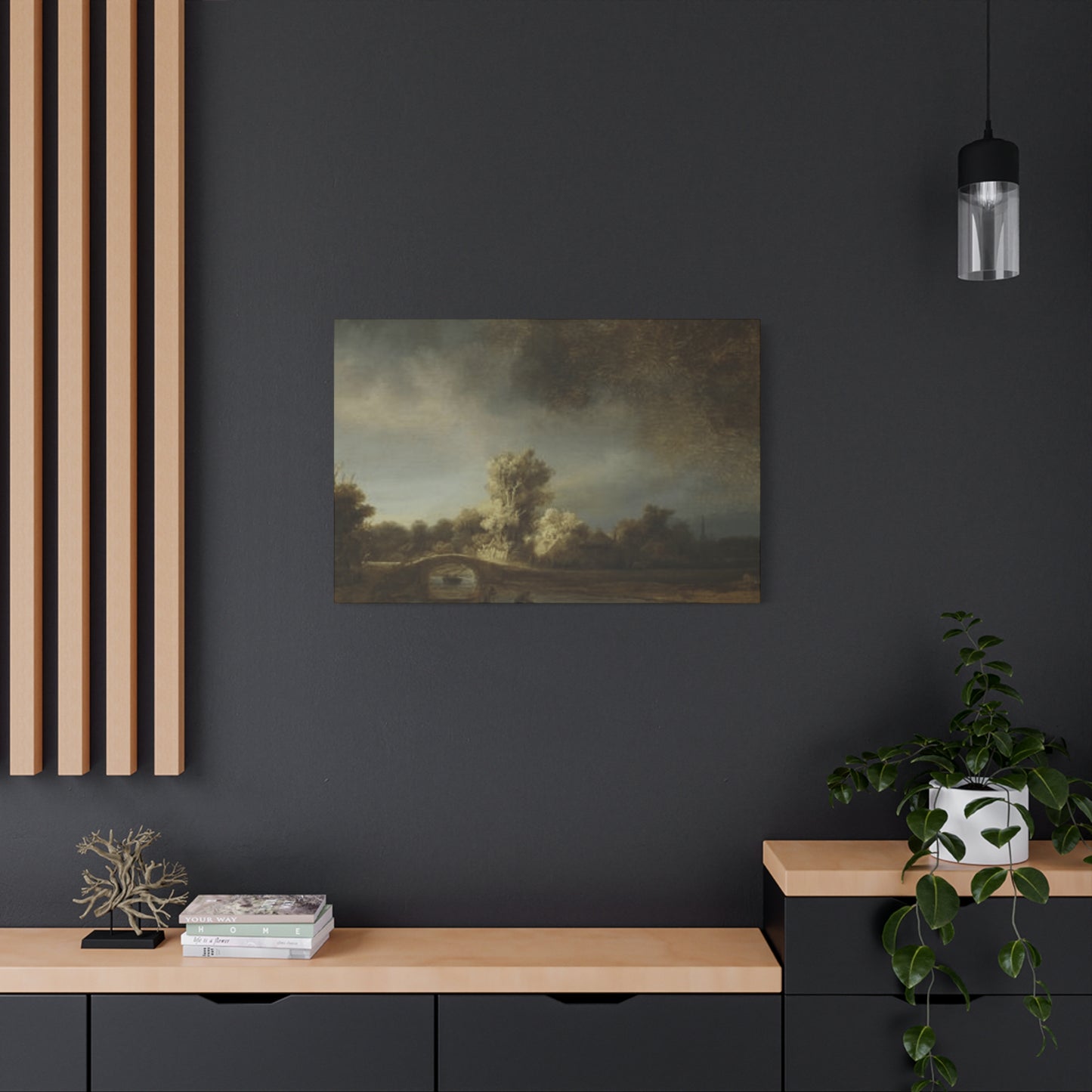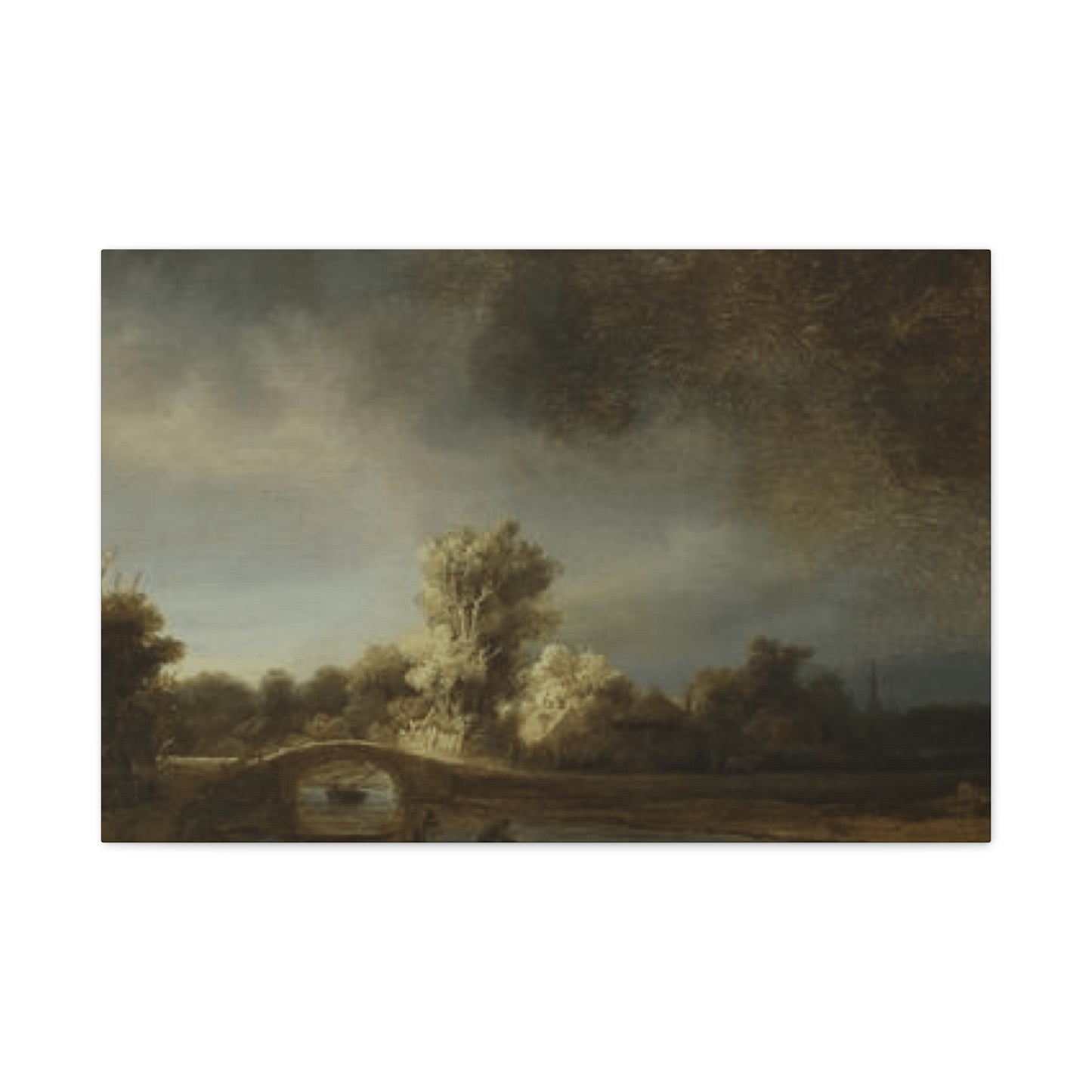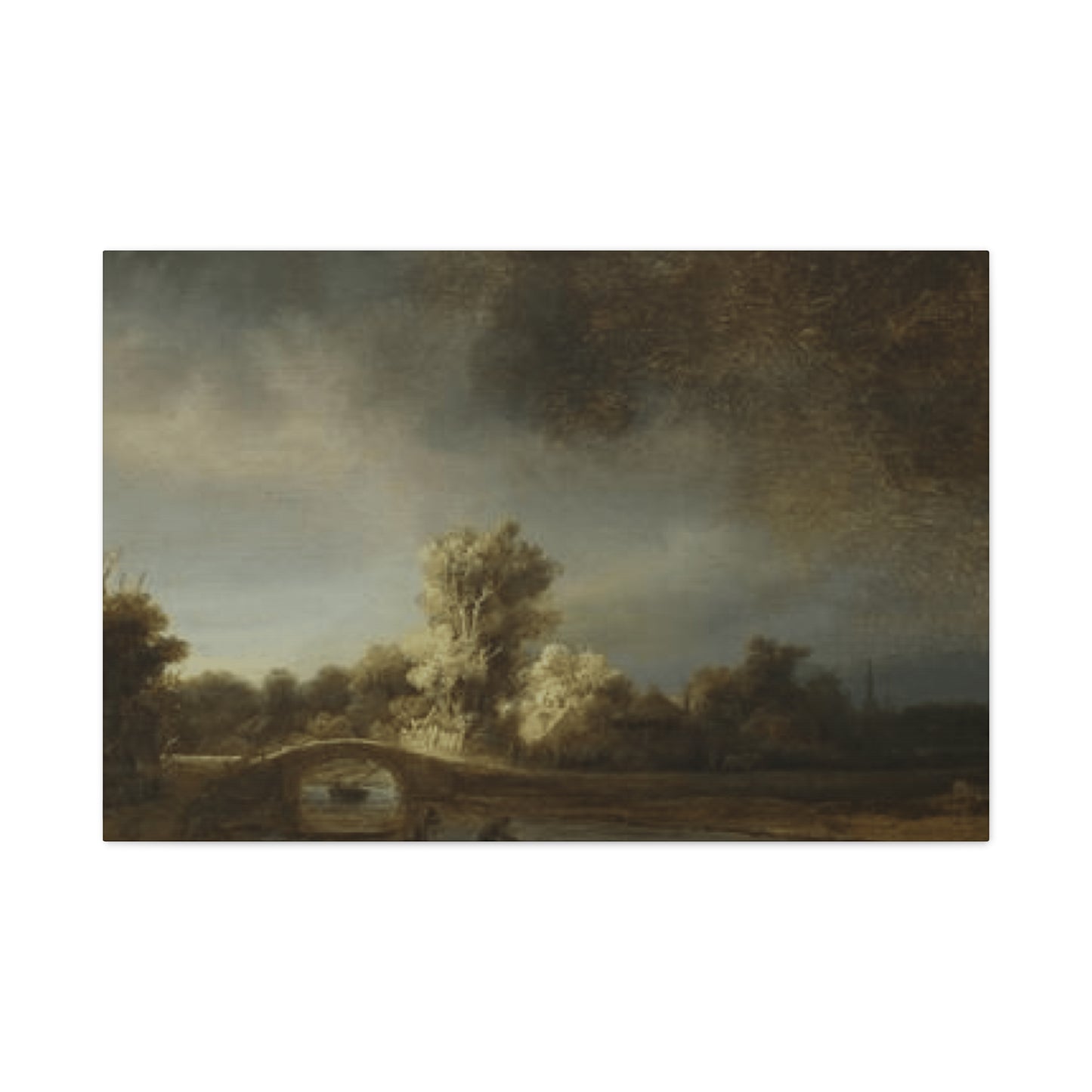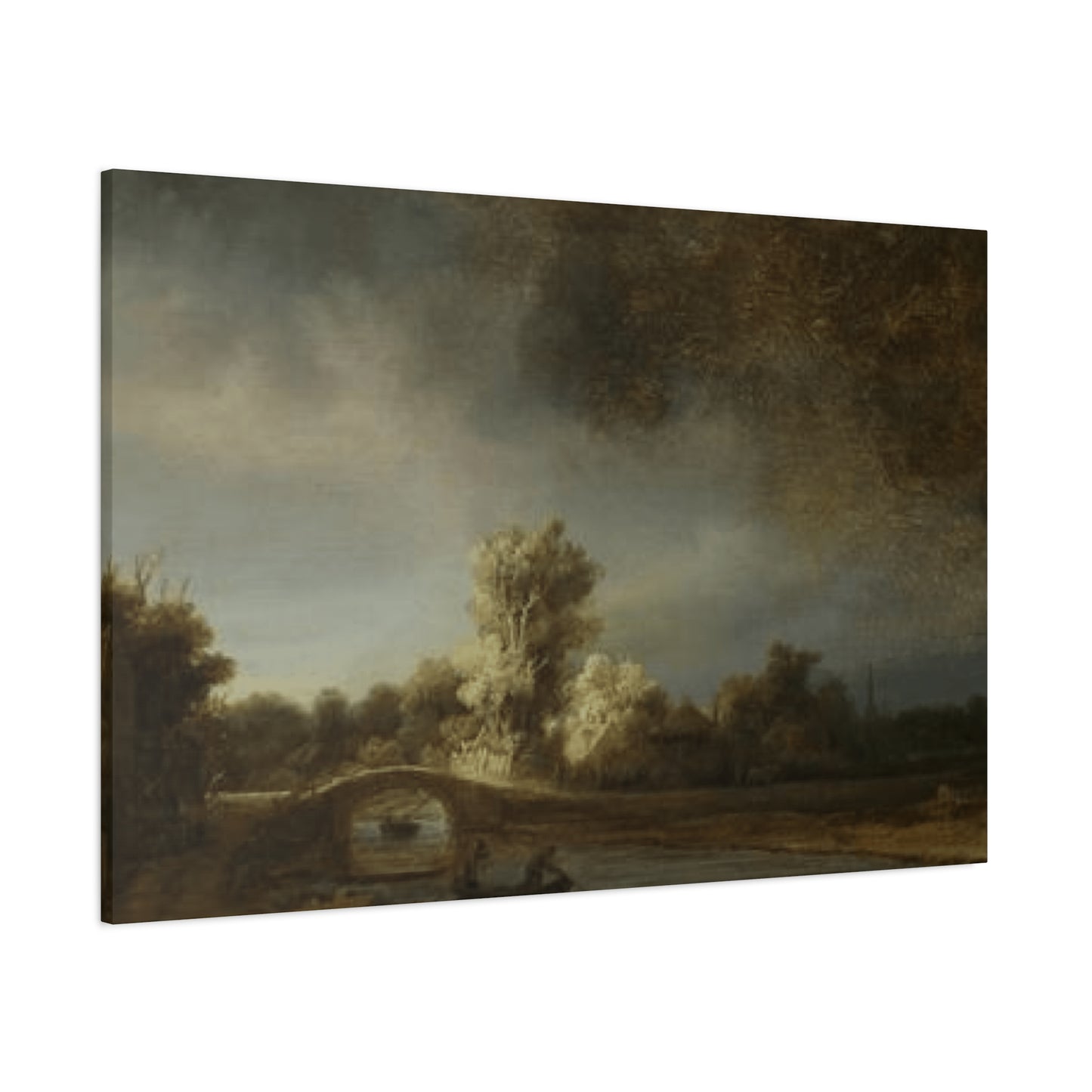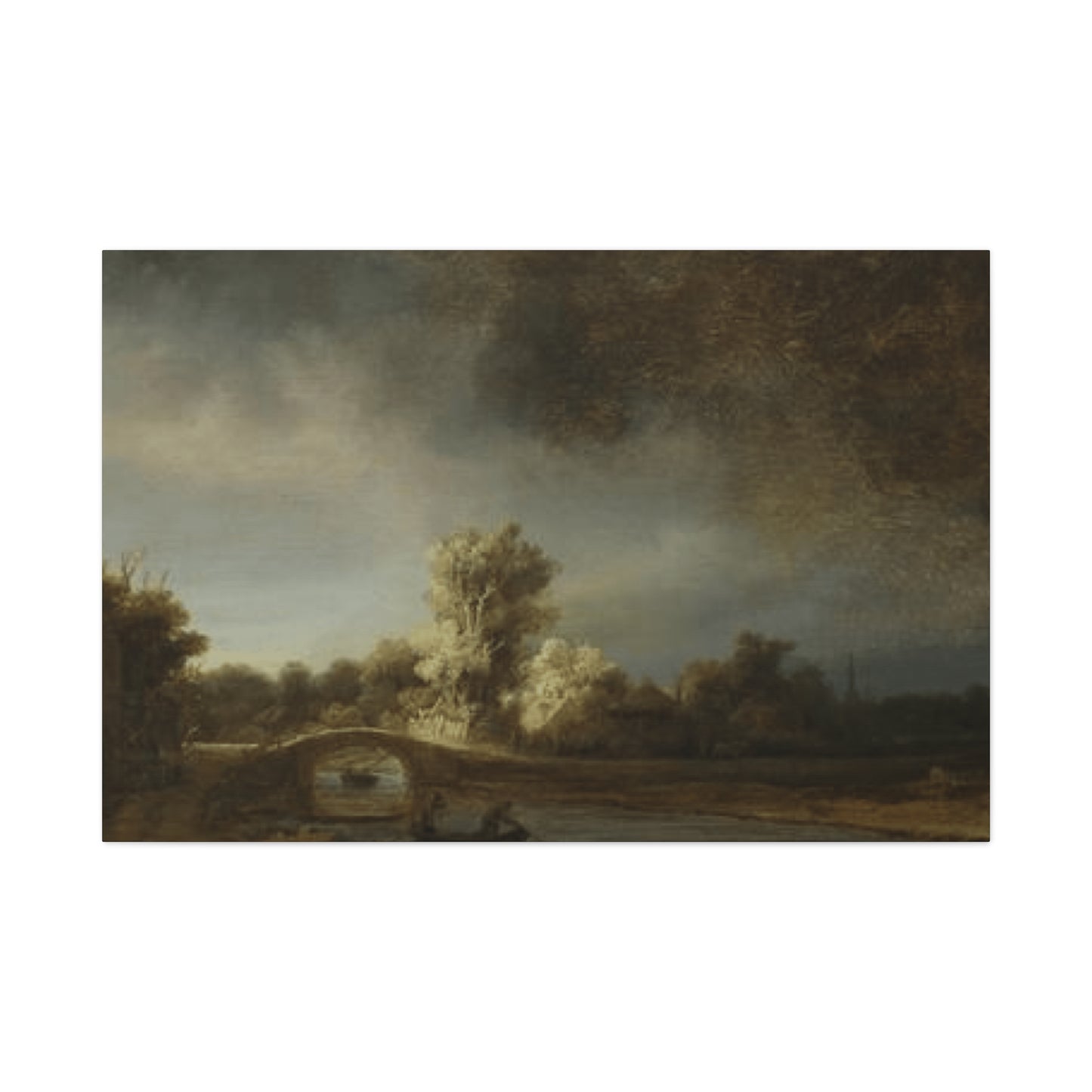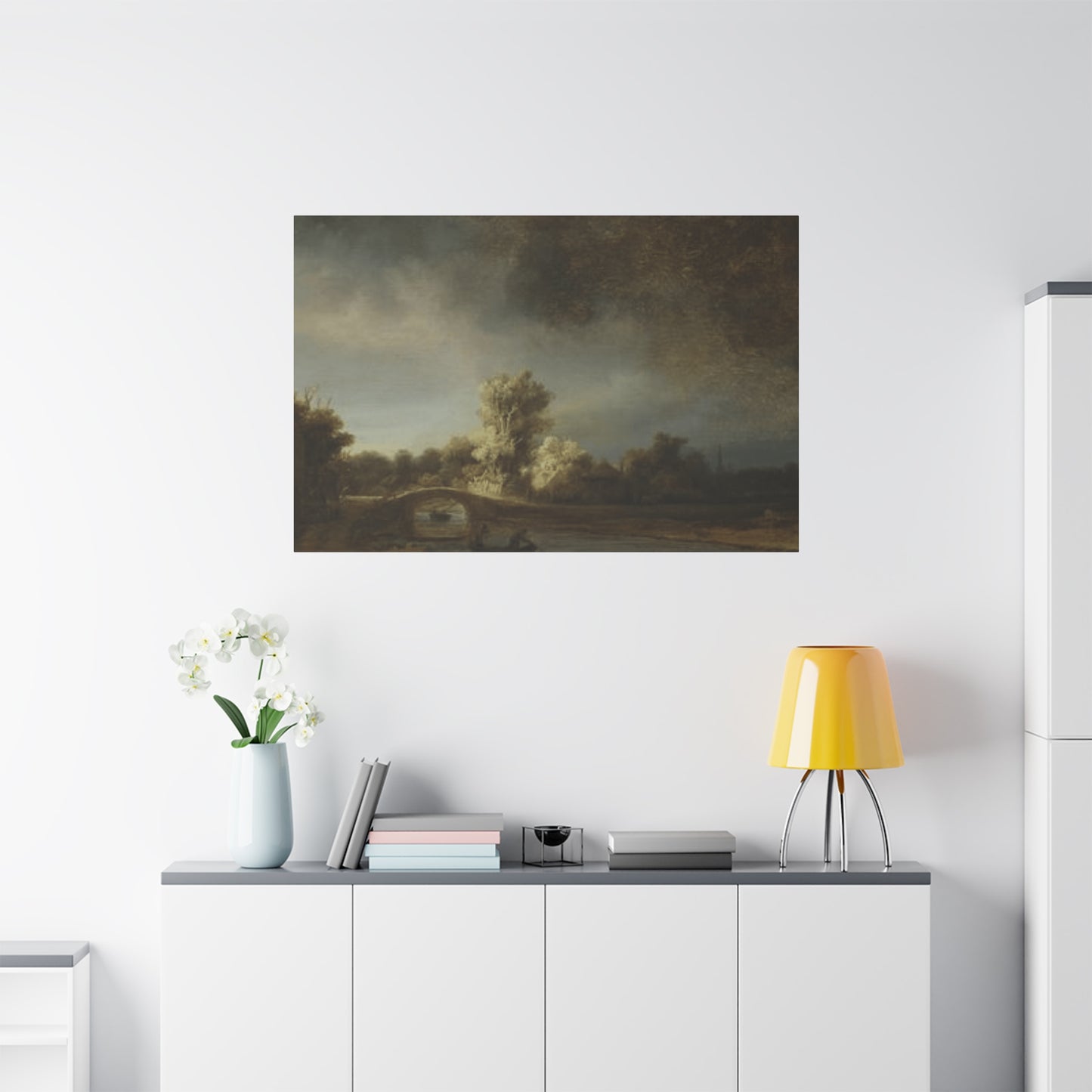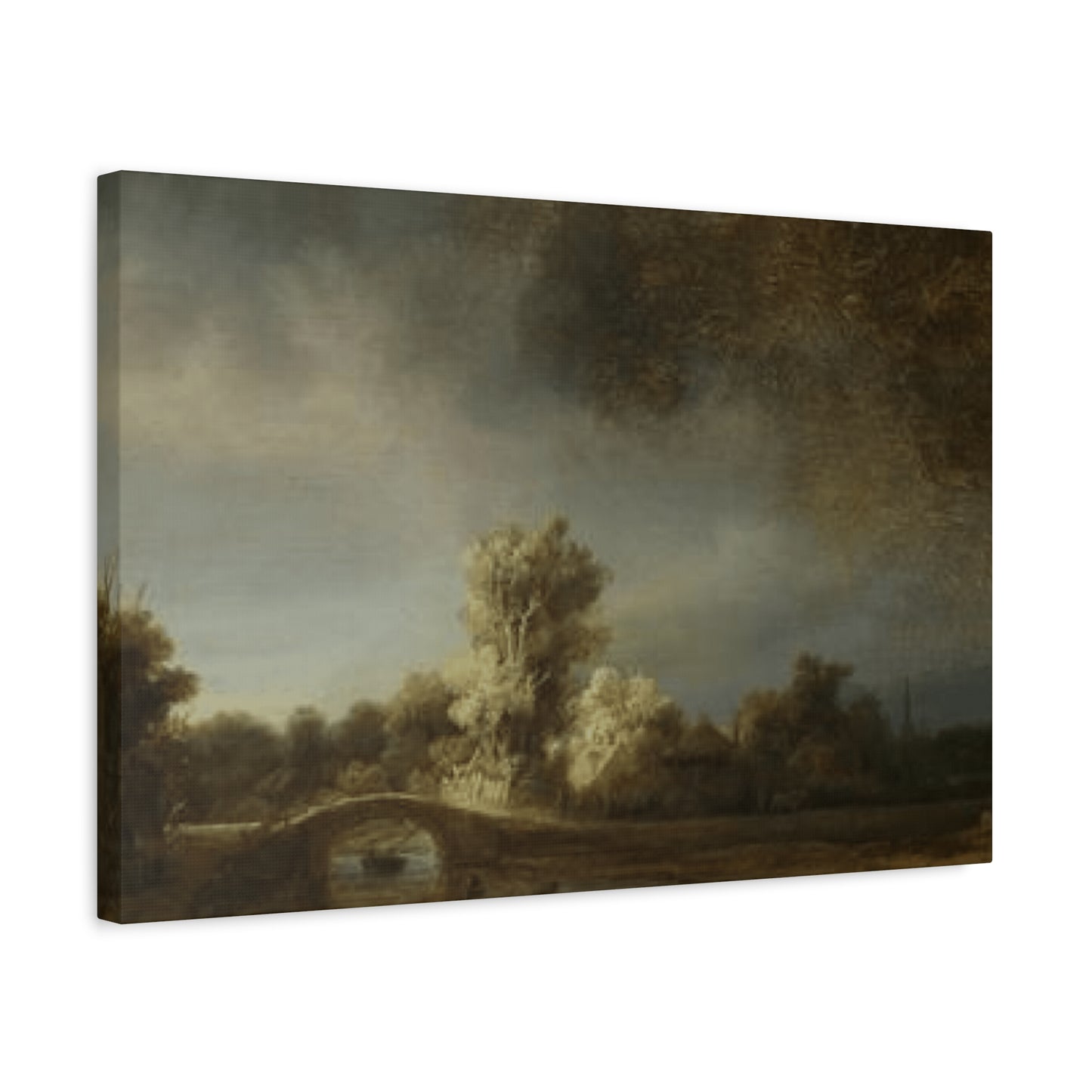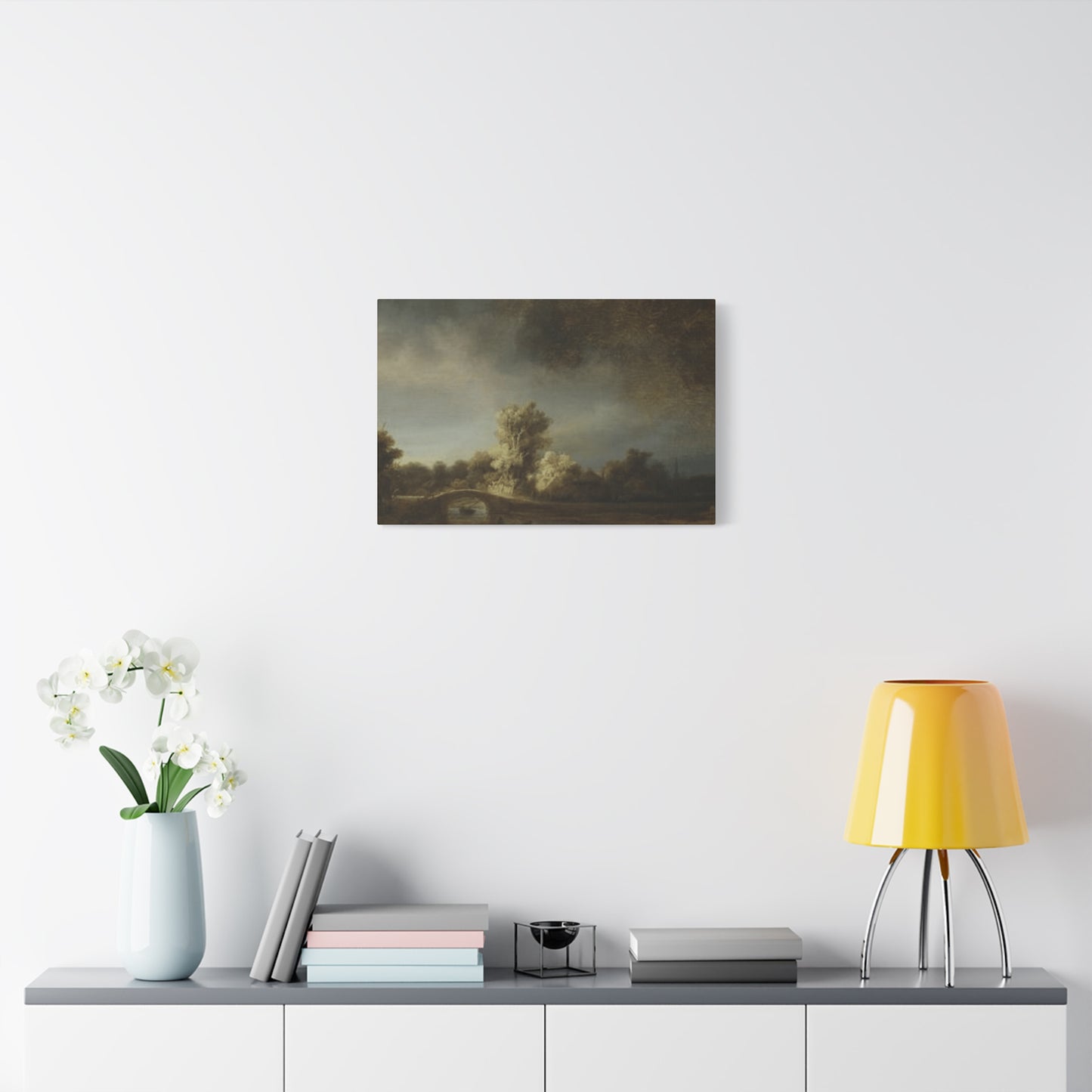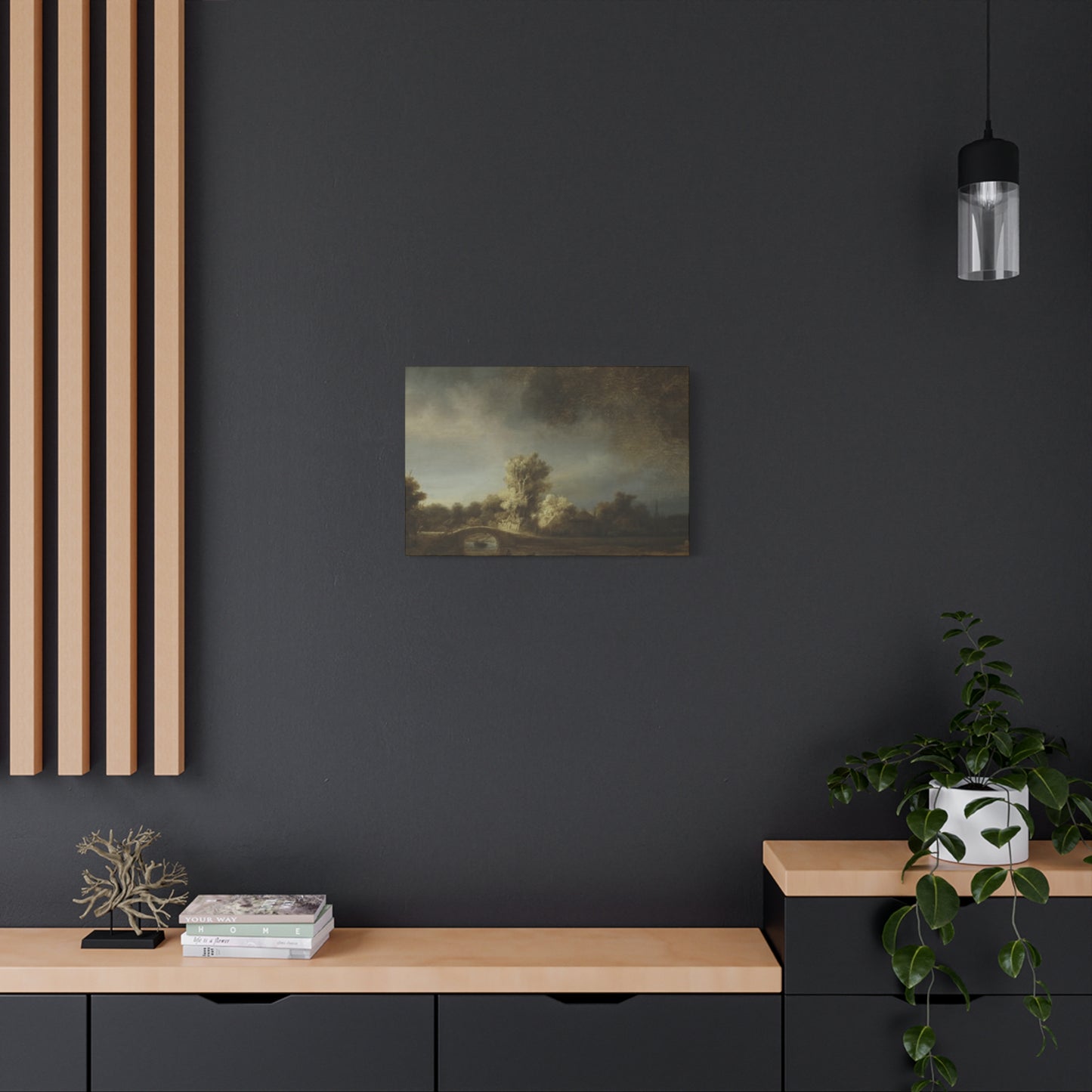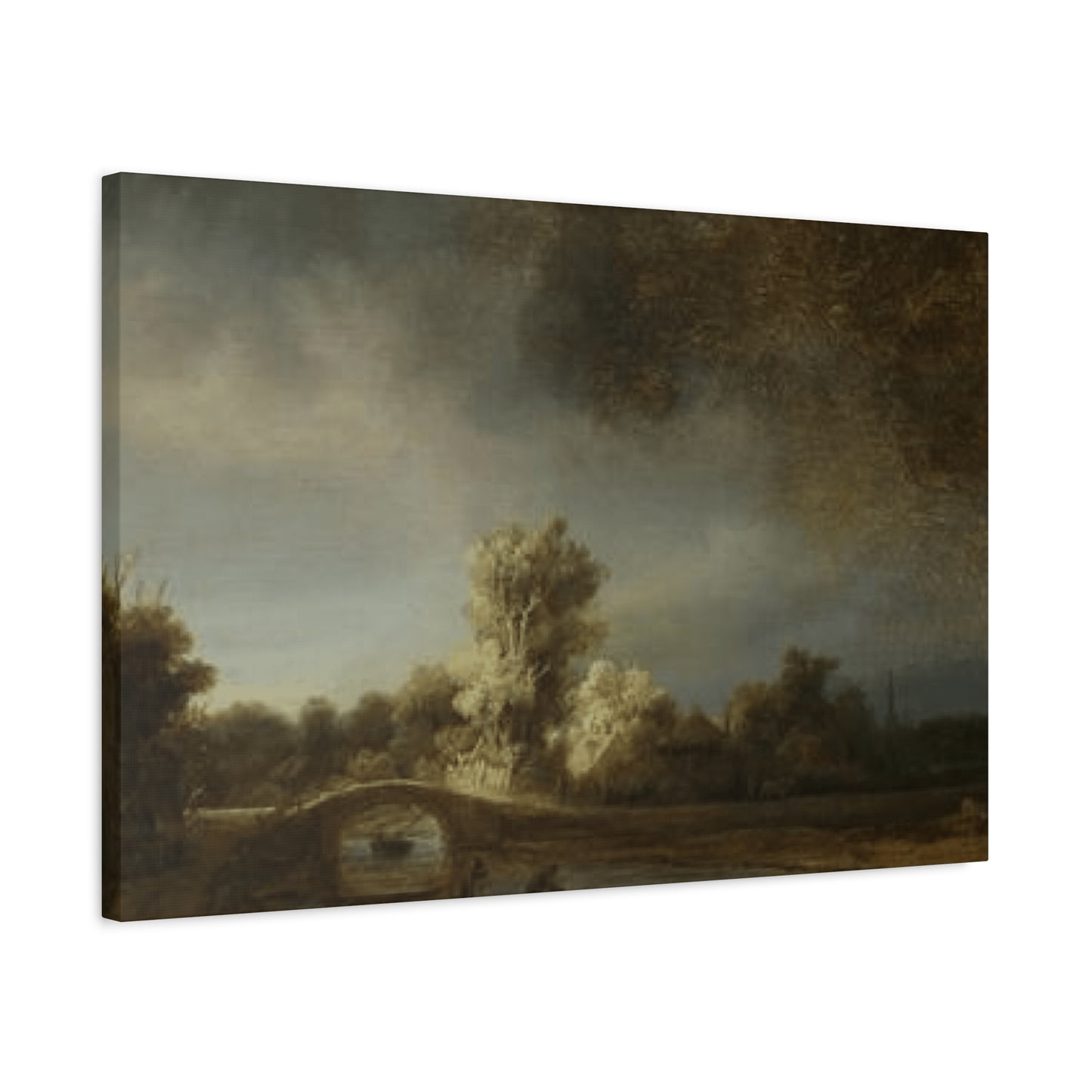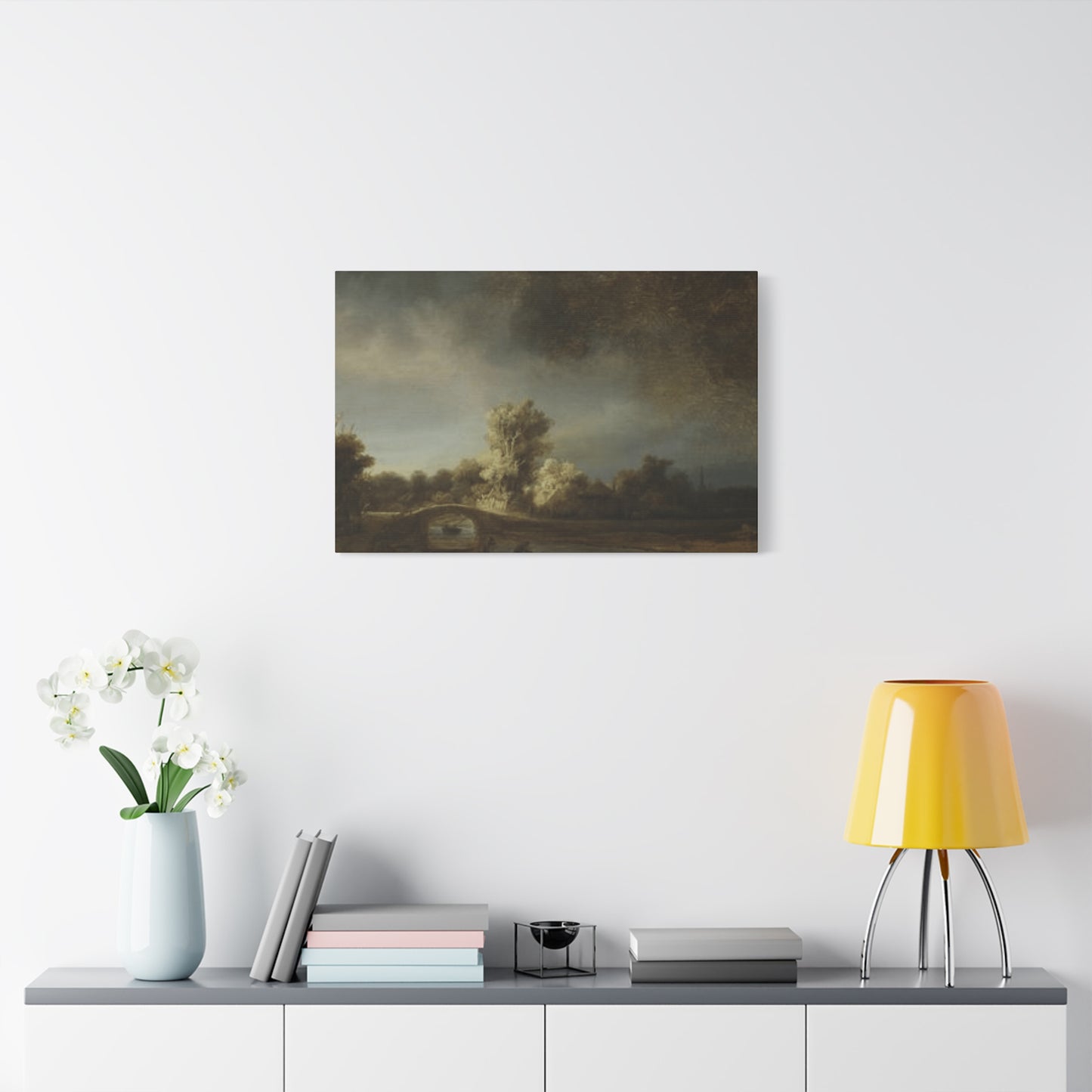Capturing Timeless Beauty: Exploring Stone Bridge Wall art Landscape Artistry
The presence of a stone bridge in a piece of landscape art transcends mere architectural detail; it acts as a powerful symbolic element, a visual anchor that connects the natural world with human history and endeavor. This particular motif, often featured in wall art, speaks to a deep, primal appreciation for both rugged nature and enduring craftsmanship. The bridge itself is a metaphor for passage, transition, and the connection between disparate places—be they physical banks of a river or abstract concepts like past and present. When rendered in paint or printed for display, the stone bridge introduces a sense of permanence and an almost nostalgic gravitas to the scene. Its rough-hewn texture contrasts beautifully with the fluidity of the water below and the organic softness of surrounding foliage, creating a dynamic visual tension.
Artists and art lovers are drawn to the composition because it offers rich opportunities for light play, particularly how shadows pool beneath the arches and how sunlight catches the mossy texture of the rock. A well-executed depiction of a stone bridge encourages contemplation. It prompts the viewer to imagine the footsteps that have crossed it over centuries, the tales it could tell, and its unwavering stand against the elements. This imagery is highly SEO friendly because it taps into evergreen search interests—people constantly seek out serene, historic, and aesthetically pleasing art for their homes. The stone bridge landscape is not just a picture; it is an escape, a doorway to a tranquil, timeless world, making it a highly desirable piece of decorative art for a wide audience. Its universal appeal lies in its ability to evoke both a sense of journey and a feeling of grounded, steadfast resilience.
Decoding the Symbolism of Arched Masonry in Fine Art
The very structure of arched masonry in a bridge holds a wealth of symbolic meaning, making it a profound choice for fine art composition. An arch is inherently strong; its design distributes weight efficiently, allowing it to withstand great pressure, and this strength is mirrored in its symbolic representation of stability and longevity. In art, particularly that destined to be wall art, the stone arch often signifies a victory over nature's obstacles—the successful spanning of a waterway or ravine. It is a testament to human ingenuity working in harmony with natural materials. Furthermore, the semi-circle of the arch naturally frames the view beyond it, acting like a lens that directs the viewer’s eye toward the deeper landscape, perhaps a distant hill or a cluster of trees. This framing technique adds depth and intentional focus to the piece.
Beyond physical strength, the arch, by its nature of enclosing an empty space, can symbolize the unknown or the future that lies on the other side. Crossing the bridge represents a momentous decision or a change in one's life path. For those looking for inspiring home décor, a print featuring such a bridge can subtly communicate themes of progress, enduring strength, and the beauty of continuity. The texture of the stones themselves—each one unique, yet all working together to form a cohesive, supportive whole—serves as a metaphor for community and interdependence. Whether the stone is granite, limestone, or slate, the artist’s rendering of its aged surface adds layers of historical context and authenticity. This focus on deep, underlying meaning enhances the value of the art beyond its surface aesthetics, appealing to a consumer base interested in purchasing pieces with intellectual and emotional resonance, a key factor in effective SEO content.
Historical Context and Artistic Legacy of Bridge Landscapes
The tradition of featuring bridges in landscape artwork is one of the most persistent and cherished themes in art history, spanning centuries and continents. From the meticulously detailed ink paintings of Chinese gardens to the romanticized oil canvases of 19th-century European masters, the stone bridge has consistently served as a vital compositional element. In the Romantic era, artists often used old, moss-covered bridges to evoke feelings of nostalgia, the sublime, and the passage of time—a contrast between the fleeting lives of people and the permanence of stone. The bridges often appeared in dramatic settings, shrouded in mist or dappled with filtered light, to amplify their emotional impact. This artistic legacy provides a rich historical context that gives modern wall art reproductions or new interpretations a sense of timeless pedigree.
The inclusion of a bridge in a painting immediately grounds the piece in a human narrative, transforming a wild scene into a place that has been traveled and experienced. Artists like J.M.W. Turner and Claude Monet, though wildly different in style, both utilized bridges to anchor their compositions and explore the interaction between built structures and the ever-changing natural environment. Monet’s Japanese-style footbridge is perhaps the most famous example, showing how the architectural form can become the subject itself. For a contemporary piece of SEO-optimized content about landscape wall art, referencing this legacy is crucial. It connects the current decorative trend to a classical art appreciation, positioning the product not merely as décor, but as an inheritor of a powerful artistic tradition. The stone bridge is, in essence, a universally recognized archetype, ensuring its continued relevance and appeal across various artistic styles and consumer demographics.
Techniques for Capturing Texture and Light on Stone
The successful depiction of a stone bridge in any form of wall art, be it a photograph, painting, or print, hinges almost entirely on the masterful rendering of texture and light. Stone, especially aged masonry, possesses a rugged, uneven surface—pocked with time, softened by moss, and often stained by mineral runoff. To capture this authentically, artists employ various techniques. In oil painting, this might involve using impasto—thick, textured applications of paint—to give the stone a tangible, rough-hewn feel. Alternatively, highly detailed cross-hatching or stippling in a fine art print can create the illusion of granular, porous rock. The goal is to make the viewer feel as though they could reach out and touch the cool, damp surface of the ancient structure.
However, texture is inseparable from the play of light. Light defines form and creates the sense of three-dimensionality necessary for a compelling composition. For a landscape featuring a stone bridge, the artist must meticulously observe how light catches the edges of individual blocks, how it highlights the subtle ridges of the mortar, and how deep, cool shadows form underneath the archway. Dramatic side-lighting, for example, is often favored as it accentuates the stone’s rough texture, adding drama and depth. In photography, this often means capturing the scene during the "golden hour" (shortly after sunrise or before sunset) to achieve long, raking shadows that visually emphasize the bridge's mass and solidity. Mastering these visual elements is key to creating a piece of unique content that stands out in the crowded wall art market, directly contributing to strong SEO performance by offering genuinely high-quality, visually rich imagery.
Styles and Regional Variations in Bridge Artwork
The appearance of a stone bridge in a piece of wall art is not monolithic; it varies dramatically depending on the architectural style and the geographical region depicted, offering a vast array of aesthetic possibilities for landscape enthusiasts. In the British Isles, for instance, you often find sturdy, low-arched, often asymmetrical packhorse bridges, designed for resilience against flooding and the passage of small trading convoys. These structures lend a rustic, pastoral quality to the art, often associated with moody, overcast skies and lush greenery. Conversely, Italian stone bridges, particularly in regions like Tuscany or the Veneto, frequently feature higher, more graceful, single or multiple semi-circular arches, often built using lighter-colored, sun-drenched limestone. These bridges inject a sense of classical elegance and warmth into the scene, immediately transporting the viewer to a place of historical romance and architectural grandeur.
Asian styles introduce another layer of variation. While not always strictly stone, bridges in traditional Japanese or Chinese landscape art often incorporate stone elements with distinct architectural features like flattened arches or segmented, moon-like openings, often surrounded by meticulously cultivated gardens. These are less about rugged function and more about aesthetic harmony and contemplative design. The specific style an artist chooses—a Roman aqueduct-like series of arches, a rugged Scottish viaduct, or a slender Venetian span—dictates the entire mood and narrative of the artwork. For consumers selecting home décor, these regional differences allow for highly personalized choices that reflect specific tastes in history, travel, or architectural appreciation.
The Role of Water and Reflection in Stone Bridge Compositions
In virtually every successful landscape artwork featuring a stone bridge, the element of water is not merely a backdrop but an active, indispensable participant in the composition. The river, stream, or pond over which the bridge spans provides the reflective surface that dramatically enhances the visual impact of the structure. Reflections in still water create a perfect, inverted symmetry, doubling the visual presence of the bridge and grounding the entire scene with an almost meditative stillness. This mirroring effect can be used by artists to explore themes of duality, balance, and the relationship between the solid world of stone and the fluid, ephemeral world of water. When the water is moving, the bridge's reflection is broken into dynamic ripples and shimmers, introducing a sense of movement and energy that contrasts with the bridge's unwavering solidity. This contrast is a fundamental principle of effective composition.
The color and clarity of the water also play a critical role in the overall mood of the wall art. Dark, deep waters might suggest mystery or depth of time, while crystal-clear streams expose the stones and pebbles beneath, adding a layer of tactile detail and transparency. Furthermore, the water often serves as the visual pathway that leads the viewer’s eye toward the bridge itself. The banks of the river act as leading lines, directing focus right to the archway, which is the compositional focal point. For a piece of SEO-friendly content, highlighting the bridge's interaction with water is essential, as the combination of stone and water is highly valued for its calming and picturesque qualities in home décor. The bridge and the water are in a perpetual dialogue, where the flow of one emphasizes the permanence of the other, creating a captivating and ceaselessly appealing motif in art that offers a sense of perpetual tranquility to any space it occupies.
Integrating Bridge Wall Art into Modern Interior Design Schemes
The timeless aesthetic of a landscape-with-a-stone-bridge makes it remarkably versatile for integrating into various modern interior design schemes, transcending its classic subject matter. In a minimalist or Scandinavian-inspired space, a black-and-white or subtly toned sepia print of a rugged stone bridge can provide necessary texture and historical weight without overwhelming the room's clean lines and neutral palette. The contrast between the antique subject and the contemporary setting creates an intriguing visual dialogue—a nod to history within a forward-thinking design environment. For rooms adhering to a rustic or farmhouse aesthetic, a color photograph or a highly textured painting of a mossy, ivy-covered bridge complements the natural materials, exposed wood, and earthy tones prevalent in those styles, emphasizing a connection to the pastoral and the enduring.
Even in more eclectic or maximalist settings, a vibrant, large-format canvas featuring a stone bridge can serve as a stunning focal point, perhaps featuring dramatic lighting or surrounding foliage in rich, saturated hues. The bridge acts as a structural element that helps organize the visual complexity of the room. The key to successful integration lies in the framing and the scale. A heavy, ornate frame will lean into a traditional style, whereas a sleek, gallery-style float frame elevates the piece to a more modern status. Because this specific type of art is strongly associated with serenity and stability, it is an excellent choice for bedrooms, studies, or corporate spaces where a calming, grounding presence is desired. Its universal appeal makes it a safe, yet sophisticated, choice for designers and homeowners alike.
Serenity, Stability, and Passage
The powerful and enduring popularity of the stone bridge landscape in wall art is rooted in its profound psychological impact on the viewer, evoking feelings of serenity, stability, and passage. The stone itself, being an elemental material, conveys an innate sense of permanence and unshakeable stability. In a world characterized by constant change and flux, viewing an image of an ancient structure that has withstood centuries of weather and water provides a deeply comforting sense of anchor and resilience. This feeling of groundedness is highly sought after in home décor, where the primary goal is often to create a sanctuary from the external world. The tranquil setting—typically involving gentle water flow and natural surroundings—further enhances the calming effect, acting as a visual cue for relaxation and mindful contemplation.
Furthermore, the stone bridge is an unequivocal symbol of passage and connection. It represents the journey across obstacles, the successful transition from one state or place to another, and the inevitable flow of time and experience. For individuals, this can be an inspiring motif, subtly encouraging the viewer to embrace change and look toward the future that lies on the other side of the span. Placing this type of art in a personal or professional space can subtly promote a positive outlook on challenges and transitions. The symmetrical beauty of the arched structure and its harmony with nature appeals to the human desire for order and balance. This deep-seated, positive emotional resonance is a critical component of its market appeal and its effectiveness as a piece of unique content.
Exploring the Color Palettes and Seasonal Moods in Bridge Artwork
The chosen color palette is a fundamental tool an artist employs to set the specific seasonal mood and overall atmosphere of a stone bridge landscape. The difference between a vibrant, sun-drenched scene and a cool, misty one can entirely change the emotional impact of the wall art. In depictions of spring, the palette will typically burst with fresh, light greens for the surrounding foliage, perhaps accented by bright, soft pastels for budding flowers and a clear, azure sky. This choice communicates renewal, hope, and lightness, making the artwork ideal for spaces where energy and revitalization are desired. Summer scenes, conversely, often feature deep, saturated emerald greens, warm earth tones on the stone, and intense blue skies, using a high contrast to convey the lush, abundant vitality of the season.
The autumnal bridge landscape is arguably one of the most popular, as it allows for the use of a dramatic and rich color palette. Here, the scene is transformed by fiery reds, deep oranges, and golden yellows in the surrounding trees, contrasting beautifully with the cool, gray-browns of the ancient stone. The light is often depicted as low and amber, casting long, dramatic shadows and adding a profound sense of melancholy and reflective beauty. This mood is highly attractive in home décor settings seeking warmth and sophistication. Winter scenes, though less frequent, offer a striking minimalist aesthetic. They rely on a limited palette of cool blues, stark whites, and the dark, textured silhouette of the stone bridge itself, conveying stillness, quiet grandeur, and the rugged endurance of the structure against the cold. By detailing how different color palettes achieve distinct seasonal moods, this unique content allows customers to make informed choices based on the emotional effect they wish to achieve, thereby optimizing the article for users searching specific aesthetic descriptions and improving its overall SEO performance within the art and décor niche.
The Artistic Medium: From Oil Painting to Digital Fine Art Prints
The effectiveness and final appearance of a stone bridge landscape are profoundly influenced by the artistic medium used to create it, ranging from traditional oil painting to modern digital fine art prints. Each medium brings its own texture, depth, and luminosity to the subject, offering distinct choices for wall art consumers. An original oil painting provides a rich, tactile surface; the thick application of paint (impasto) can perfectly mimic the rugged texture of the stone and the dense layering of foliage. Oils allow for subtle blending and deep, atmospheric chiaroscuro, creating a sense of historical weight and material presence that is highly prized by collectors. The investment in an oil painting is often seen as a premium choice that emphasizes tradition and craftsmanship.
Watercolor, by contrast, offers a lighter, more ethereal representation. The transparency of the medium is excellent for conveying mist, filtered light, and the fluidity of the water beneath the stone bridge, resulting in an artwork that feels delicate, fresh, and spontaneous. In the contemporary market, however, the majority of accessible landscape wall art is created as high-quality digital fine art prints, often using the Giclée method. This medium allows artists to work digitally, achieving a level of detail and color accuracy that rivals traditional methods, and critically, it makes stunning artwork highly accessible and scalable. A well-produced Giclée print on textured canvas or archival paper retains the richness of the original artwork (be it a photograph, digital painting, or scan of a traditional piece) while offering a durable and cost-effective solution for home décor. Understanding the characteristics of each artistic medium—from the luminosity of acrylics to the precision of a digital render—is essential for any consumer, and providing this detailed comparison enhances the informational value and SEO-friendliness of the article.
Framing, Leading Lines, and the Rule of Thirds
The magnetic appeal of a well-crafted landscape-with-a-stone-bridge in wall art is a direct result of the artist's skillful application of various compositional techniques. These techniques guide the viewer's eye through the scene, ensuring the stone bridge is the undeniable focal point while maintaining overall visual harmony. Leading lines are perhaps the most vital of these tools; the banks of the river, a meandering path, or the receding lines of the bridge's archways all act as visual arrows that direct the gaze precisely to the central structure. This creates a powerful sense of depth and movement, inviting the viewer to metaphorically "walk" into the scene.Framing is another powerful technique inherent to this motif. The arch of the bridge itself acts as a natural frame, highlighting a specific portion of the distant landscape—perhaps a distant mountain or a cluster of trees.
This compositional device adds depth and mystery, encouraging the viewer to look beyond the immediate foreground. Furthermore, the Rule of Thirds is almost universally applied. By placing the bridge or its most interesting feature (such as the highest point of its arch) along the intersecting lines of a visual grid, the artist creates a more dynamic and pleasing arrangement than simply centering the structure. Placing the horizon line on the upper or lower third, rather than the middle, also contributes to a more balanced and engaging image. Mastering these techniques—the careful use of leading lines, strategic framing, and adherence to the Rule of Thirds—is what elevates a simple photograph or painting of a bridge into a compelling, professional piece of unique content highly sought after for SEO and artistic value in the home décor market.
Capturing Time and History: Patina, Moss, and the Marks of Age
One of the most profound aspects of the stone bridge landscape as a subject for wall art is its ability to capture time and history. The bridge is a physical record of the passage of years, and artists often focus intently on rendering the patina, moss, and the marks of age to tell this story. A bridge that appears freshly built lacks the emotional resonance of one covered in the green, velvety texture of moss or stained by centuries of mineral-rich water runoff. The delicate depiction of moss and lichen clinging to the granite or sandstone blocks immediately conveys antiquity, suggesting a structure that has witnessed countless seasons and human events. This detail is not just aesthetic; it imbues the artwork with a deep sense of historical authenticity and romanticism.The presence of weathered cracks, chipped edges, or even subtle structural dips in the masonry—the marks of age—speaks to the resilience of the structure.
These imperfections are what make the bridge relatable and beautiful, providing texture that contrasts with the smoothness of the water or the sky. Artists use subtle shifts in color—from the original gray or tan of the stone to the rust-colored stains of iron in the water—to communicate the chemical and physical weathering process. By focusing on these signs of age and endurance, the wall art becomes a silent monument to constancy. This theme of enduring strength and historical narrative is a highly valuable component for SEO-friendly content, as buyers often search for artwork that feels meaningful, historic, or "old-world." The detailed rendering of the stone's age transforms the bridge from a simple crossing structure into a powerful, symbolic centerpiece for any piece of unique landscape décor.
Mastering Perspective and Depth in Stone Bridge Artwork
The creation of a believable and engaging stone bridge landscape relies heavily on the artist’s ability to master perspective and depth. Without careful attention to these elements, the wall art can appear flat and lifeless, failing to draw the viewer into the scene. Effective use of linear perspective is crucial, as the parallel lines of the bridge's edges and the riverbanks appear to converge toward a single vanishing point on the horizon. This convergence gives the image its three-dimensional illusion, making the bridge seem to recede realistically into the distance. This visual trickery is what gives the art its power to transport the viewer to another place.Furthermore, aerial or atmospheric perspective plays a vital role in enhancing depth. Objects that are closer—like the mossy stones in the foreground—are depicted with greater detail, sharper edges, and more saturated colors.
As the landscape recedes toward the vanishing point, the colors become cooler, the values lighter, and the details blur slightly, mimicking the effect of atmospheric haze. This technique creates a tangible sense of distance between the immediate foreground, the central focus of the stone bridge, and the far background, such as a distant mountain range or forest. Artists may also use the size and placement of elements like trees or figures near the bridge as scale indicators to further exaggerate the bridge's impressive size and the vastness of the surrounding landscape. By skillfully manipulating these laws of perspective and depth, the art becomes more than just a picture; it becomes a deep, enveloping vista. For SEO-friendly content, emphasizing this sophisticated visual engineering assures potential buyers that the artwork possesses the quality and aesthetic complexity required to be a truly commanding and enduring piece of home décor.
The Interplay of Nature and Architecture in the Bridge Motif
The fundamental appeal of the stone bridge motif in landscape wall art lies in the compelling interplay of nature and architecture. This visual juxtaposition—the contrast between the rugged, organic forms of the natural environment and the deliberate, engineered structure of the bridge—is a powerful source of aesthetic tension. The bridge, built by human hands, represents civilization, permanence, and the mastery of materials, yet it is simultaneously being reclaimed by the wilderness. Vines creep over the sturdy stones, moss softens the sharp lines, and the constant flow of the river beneath slowly erodes its foundation. This dialogue between the enduring structure and the irresistible force of nature is rich with symbolic meaning.Artists often enhance this interplay by using contrasting textures. The smooth, flowing lines of the river and the soft, varied textures of the trees and foliage are set against the hard, rigid, and geometric forms of the stacked masonry.
This contrast makes both elements stand out more dramatically. In a well-composed piece of art, the bridge doesn't dominate the landscape; rather, it exists in conversation with it, suggesting a harmonious relationship where human endeavor respects and blends with the environment. This theme of balance is highly attractive in contemporary home décor, where there is a strong movement towards incorporating natural elements and promoting environmental consciousness. For the purposes of SEO, highlighting the organic synthesis between the architecture of the stone bridge and the wild beauty of nature taps into multiple search interests: art that is both structural and serene, historic and earthy, thus ensuring the unique content reaches a broad and appreciative audience looking for meaningful and visually striking pieces.
The Bridge as a Narrative Element: Telling Stories in Canvas
Within the realm of landscape wall art, the stone bridge often functions powerfully as a narrative element, capable of telling stories without the need for figures or explicit action. The image of the bridge inherently suggests motion, journey, and the crossing of a barrier. It invites the viewer to fill in the blanks: Who built this bridge, and for what purpose? What travelers have passed over it, and where were they going? The worn stones and the signs of age become the silent chapters of a long, untold history. This innate narrative quality elevates the artwork beyond a simple scenic view, making it a piece that engages the viewer's imagination and personal interpretation.The setting around the bridge significantly informs the story. A bridge tucked away in a dense, secluded forest suggests a hidden, forgotten path and themes of exploration or solitude.
A bridge crossing a wide, busy river near a distant village suggests themes of community, commerce, and connection. If the wall art depicts the bridge in ruins, it speaks of the passage of empires and the eventual triumph of time over all human endeavors, a poignant meditation on mortality. This ability of the stone bridge to anchor a silent story is a huge part of its enduring popularity as a subject. When crafting SEO-friendly content, emphasizing this narrative element—how the landscape and its central feature, the stone bridge, can evoke a sense of mystery, history, and adventure—is highly effective. People purchase art not just to decorate, but to stimulate thought and provide a sense of place or purpose, making the narrative depth of this subject a key selling point and a source of genuinely unique content.
Customizing Wall Art: Selecting Size, Framing, and Display
Once the decision is made to acquire a stone bridge landscape for home décor, the final presentation—customizing wall art through careful selection of size, framing, and display—is critical to maximizing its impact. The size of the art should be proportional to the wall space it occupies. A smaller print, perhaps focused on a detail of the bridge, works well in a gallery wall arrangement or a confined space like a hallway. Conversely, to serve as a dramatic focal point in a living room, a large-format canvas or framed print can command attention, creating a window-like portal to the tranquil landscape. Ensuring the scale is right prevents the art from looking either dwarfed or overwhelming.The choice of framing profoundly influences the art's stylistic presentation. A traditional, ornate gold or dark wood frame will reinforce the historical and classical nature of the stone bridge motif.
For a more contemporary feel, a sleek, minimalist black or white metal frame, or even a canvas wrapped print, will modernize the piece, allowing the image itself to take precedence. The display method also matters. Positioning the art where natural light can graze its surface enhances the texture of the stones and the depth of the composition. For maximum impact, consider hanging the piece at eye level (center of the art should be about 57-60 inches from the floor). Providing detailed guidance on customizing wall art with optimal size, framing, and display techniques transforms this unique content into an actionable resource for consumers. This specificity aids SEO by capturing long-tail search queries related to the practical application of art in interior design and ensures the chosen landscape-with-a-stone-bridge print will realize its full aesthetic potential.
Resolution, Materials, and Longevity of Prints
When selecting wall art featuring a stone bridge landscape, understanding the technical considerations related to print resolution, materials, and longevity is crucial for ensuring a high-quality, lasting investment. For any digital print, the resolution must be high enough to prevent pixelation, especially for large-format pieces. Professional prints require a minimum of 300 dots per inch (DPI) at the final display size to accurately capture the fine details of the stone texture, the leaves on the trees, and the subtle variations in the water’s reflection. Low resolution will diminish the impact of the perspective and depth, making the otherwise compelling image look amateurish.The materials used for the print itself directly affect the aesthetic and durability.
Archival papers, such as cotton rag or alpha-cellulose, offer a superior matte or satin finish that enhances the depth and range of colors, while providing museum-quality longevity. Canvas prints offer a textured look that mimics traditional painting, often favored for rustic or traditional home décor settings. Furthermore, the ink used is paramount for longevity. Giclée prints, which utilize pigment-based inks instead of dye-based inks, are resistant to fading, ensuring the vibrant greens, earthy browns, and tranquil blues of the landscape remain true for decades, even when exposed to ambient light. Consumers who search for premium, durable wall art are often focused on these technical considerations. By detailing these factors, this unique content elevates the discussion beyond mere aesthetics, appealing to quality-conscious buyers and providing highly specific, SEO-friendly information that distinguishes the art as a long-term investment rather than a temporary decoration.
The Influence of Light Direction and Time of Day on Mood
The artist's choice of light direction and time of day is arguably the most powerful tool for manipulating the mood and dramatic impact of a stone bridge landscape in wall art. A midday sun, depicted directly overhead, results in flat, uniform lighting with minimal shadows, often creating a bright, clear, and unambiguous mood of straightforward clarity and casual observation. While cheerful, this approach lacks the drama of more intentional lighting. Far more compelling are scenes captured during the "magic hours."Morning light, with its cool, slightly blue tones and soft, horizontal rays, can bathe the stone bridge in a gentle, fresh glow, often accompanied by mist rising from the water. This lighting creates a mood of serenity, new beginnings, and quiet hope. Sunset lighting, by contrast, is warm, golden, and casts long, deep shadows.
This dramatic side-lighting enhances the texture of the rough stone, emphasizes the depth of the arches, and evokes a mood of reflective nostalgia, closure, and sometimes, a poignant melancholy. Backlighting, where the sun is positioned behind the bridge, can create a striking silhouette effect, emphasizing the bridge's strong, defined shape against a luminous sky. This technique adds mystery and powerful graphic impact. The skillful management of light direction and time of day dictates whether the landscape wall art is perceived as tranquil, dramatic, or contemplative, offering consumers specific emotional palettes to match their home décor goals. Articulating these nuances makes the unique content highly specific and relevant to buyers seeking art based on a particular atmosphere, significantly boosting its SEO efficacy.
Stone Bridge Art as an Investment in Tranquility and Wellness
In an era of increasing focus on mental well-being and mindful living, acquiring stone bridge art can be viewed as an intentional investment in tranquility and wellness. The visual characteristics inherent to this specific type of landscape wall art are scientifically proven to elicit calming physiological responses. The presence of natural elements—water, trees, and sky—activates the parasympathetic nervous system, promoting relaxation and reducing stress. The stone bridge itself, with its deep roots in history and its powerful symbol of stability and endurance, acts as a visual anchor, fostering a sense of psychological grounding.Placing a serene stone bridge landscape in a high-stress area like a home office or bedroom provides an immediate visual escape.
The composition, often featuring leading lines and a clear sense of order, satisfies the human brain's desire for symmetry and balance, contributing to a feeling of inner peace. Unlike abstract or highly dramatic art, this subject offers an accessible, universally positive aesthetic that requires no intellectual decoding, allowing the viewer to instantly relax into the scene. For the purposes of SEO, framing the wall art selection not just as a decorative choice but as a lifestyle purchase—an investment in tranquility and mental wellness—taps into the booming market for biophilic design and mindful living products. This positioning highlights the unique value proposition of the stone bridge motif, transforming it into a piece of unique content with genuine emotional and psychological benefits, making it an essential element of restorative and thoughtful home décor.
Comparing Styles: Realism, Impressionism, and Abstract Interpretations
While the core subject remains the stone bridge landscape, the artistic presentation can vary dramatically depending on the chosen style, leading to fascinating comparisons between realism, impressionism, and abstract interpretations for wall art. Realism seeks to represent the scene with meticulous accuracy, focusing on sharp detail, precise proportion, and faithful color reproduction. A realistic depiction of a stone bridge emphasizes the texture of the masonry, the specific species of surrounding foliage, and the clarity of the water, offering a true-to-life window into the landscape. This style is generally preferred by those who value clarity, detail, and traditional artistic skill in their home décor.Impressionism, conversely, prioritizes the capture of a fleeting moment and the effect of light and color over structural detail. An Impressionistic rendering of a stone bridge might feature loose brushstrokes, blurred edges, and a focus on how the light reflects off the water and the stone at a particular time of day.
The structure itself is secondary to the atmosphere and the sensory experience. This style offers a softer, more emotional, and highly aestheticized view. Finally, abstract interpretations move away from literal representation entirely. The artist might use the form of the stone bridge—its arches, vertical supports, and horizontal span—as a starting point for exploring color blocks, geometric patterns, or emotional tones. While less common, an abstract interpretation provides a modern, intellectual, and highly stylized piece of unique content. Understanding these stylistic variations allows consumers to select the art that best aligns with their personal aesthetic and the prevailing style of their interior, making this detailed comparison a crucial component of this SEO-friendly and comprehensive article.
Determining Value and Authenticity in Bridge Prints
Understanding the economics of art is essential when investing in a stone bridge landscape print, particularly regarding the factors that determining value and authenticity. The perceived value of wall art is not solely based on its visual appeal but also on technical and market factors. Key determinants of value include the edition size; a limited edition print (e.g., 1/50) by an established photographer or artist is inherently more valuable than an open edition or a mass-produced poster. The lower the print run, the higher the collectability and, consequently, the price. Authenticity is primarily guaranteed through documentation. A reputable art seller or gallery will always provide a Certificate of Authenticity (COA), which details the artist's name, the title of the work, the medium (e.g., Giclée print on archival paper), the edition number, and the date. This document is often signed by the artist, which is a critical authenticity mark.
Furthermore, the materials used, as discussed previously, impact the long-term value. Prints on high-quality archival paper and pigment-based inks hold their color and material integrity, ensuring their longevity and preserving their aesthetic value over time. Artwork by artists with a rising profile or significant recognition will appreciate in value, transforming the wall art from a simple decorative piece into a tangible asset. For the environmentally and ethically conscious buyer, the sustainability of the printing process and the provenance (origin) of the work can also add a perceived layer of value. By focusing on these economic and authenticity markers, this unique content positions the purchase of a stone bridge landscape as an informed and quality-driven decision, appealing to the sophisticated segment of the home décor market and optimizing for advanced SEO queries related to art investment and provenance.
The Bridge in Focus: Foreground Detail Versus Background Vista
A crucial compositional decision in creating a captivating stone bridge landscape involves the balance between foreground detail versus background vista. This choice dictates the viewer’s experience and the kind of narrative the wall art conveys. An artist who chooses to prioritize foreground detail will meticulously render the immediate vicinity of the bridge: individual mossy stones, small flowers growing by the riverbank, and the specific texture of the water closest to the viewer. This approach draws the viewer's eye into the immediate, tactile world of the scene, creating a sense of intimacy and tangible reality. The bridge itself may be large and imposing, filling a significant portion of the frame, allowing its architectural character to dominate.
Conversely, a composition that emphasizes the background vista treats the stone bridge less as a subject and more as a compositional tool. Here, the bridge is often smaller in the frame, perhaps slightly off-center, acting as an elegant entryway into a vast and expansive landscape. The viewer’s attention is then directed toward the distant elements—a dramatic mountain range, a sprawling forest, or a sweeping sky. This creates a sense of openness, journey, and the sublime, making the artwork feel epic and boundless. The choice between emphasizing foreground detail or the background vista must align with the intended emotional impact. An emphasis on detail provides comfort and enclosure, while a focus on the vista inspires aspiration and freedom. Recognizing this compositional dichotomy helps consumers select the landscape wall art that perfectly matches the mood they want to create in their home décor, adding a layer of sophisticated analysis that makes this unique content highly valuable and SEO-friendly.
Ensuring the Longevity of Your Wall Art
Once a beautiful stone bridge landscape wall art piece is acquired, proper maintenance and care are paramount to ensuring its longevity and preserving its aesthetic integrity. Regardless of the medium—be it a canvas print, a fine art photograph, or a print behind glass—certain precautions must be taken to protect the investment. The most significant threat to the artwork is direct sunlight, which contains harmful UV rays that cause pigments to break down and fade over time. Therefore, the piece should be hung on a wall that does not receive direct, intense sun exposure during the day. If this is unavoidable, choosing prints made with archival pigment inks and protected with UV-filtering glass or acrylic is essential for longevity.
Environmental conditions, specifically temperature and humidity, also play a crucial role. Extremes or rapid fluctuations in temperature and high humidity can cause paper to warp, canvases to stretch and slacken, and frames to crack. Art should ideally be displayed in a stable environment, avoiding areas like bathrooms or unventilated basements. Regular maintenance is straightforward, usually involving gentle dusting with a soft, clean, lint-free cloth or a very soft brush. Chemical cleaners should never be used on the print surface itself. For framed pieces, only the glass or acrylic covering should be cleaned with a specialized, non-ammoniated cleaner, sprayed onto the cloth first, not directly onto the frame. Providing these practical care and maintenance instructions for wall art makes this section of the unique content highly useful to the consumer, demonstrating comprehensive knowledge of the product and contributing to a superior SEO profile by addressing practical customer needs.
The Bridge as a Cultural Icon: Regional Differences and Artistic Interpretation
The stone bridge is far more than an engineering feat; it serves as a powerful cultural icon, with its meaning and aesthetic varying widely based on regional differences and artistic interpretation. In many parts of Europe, these bridges—be they Roman aqueducts in Spain, medieval bridges in France, or classic hump-backed bridges in the UK—are physical markers of a long, interconnected history. They symbolize the cultural movement of people, goods, and ideas across centuries. The artistic interpretation of these European bridges often focuses on themes of pastoral nostalgia, human endurance, and the weight of history, often rendered with a sense of classical respect.
Conversely, in Asian landscape art, bridges, while often incorporating stone elements, are viewed through a lens of philosophical contemplation. They are essential elements in the design of classical gardens, symbolizing a path to enlightenment or the journey across the waters of life. The artistic interpretations here—often precise, minimalist, and harmoniously integrated into the natural environment—reflect a cultural emphasis on balance and reflection rather than rugged utility. The distinction between a ruggedly functional European span and a slender, ornamental Japanese or Chinese bridge highlights how the same architectural element takes on vastly different cultural meanings and inspires diverse artistic interpretations.
Conclusion:
The landscape with a stone bridge stands as one of the most resonant and enduring motifs in the history of wall art, a subject that consistently captivates artists and homeowners alike. Over the course of this extensive exploration, we have dissected the profound appeal of this imagery, tracing its roots from classical artistic legacy to its current iteration as a staple of sophisticated home décor. The stone bridge, whether rendered through the heavy impasto of oil painting, the lightness of watercolor, or the precision of digital fine art prints, serves as a powerful symbol of permanence, connection, and the inexorable passage of time.
Its magnetic quality is rooted in the compelling interplay of nature and architecture. The ancient, moss-covered masonry acts as an unwavering anchor against the fluid, ever-changing environment of water and foliage. This juxtaposition provides a psychological comfort, offering a visual representation of stability and resilience in an increasingly transient world. We’ve seen how the artist’s mastery of compositional techniques—the leading lines of the riverbanks, the natural framing of the arches, and the strategic use of perspective—conspire to draw the viewer into the scene, transforming a flat piece of wall art into a deep, immersive vista. The intentional use of color palettes and light direction further manipulates the mood, allowing the artwork to embody anything from the serene hope of morning light to the reflective drama of an autumnal sunset.
Furthermore, selecting a stone bridge landscape is an investment in tranquility and wellness. The visual language of natural elements and stable structure promotes relaxation and provides a crucial sense of escape, making it an ideal feature for any space dedicated to peace and contemplation. The aesthetic choices surrounding its presentation—from the regional style of the bridge (be it European, Asian, or imagined) to the selection of size, framing, and display—allow for a high degree of personalization, ensuring the final piece perfectly complements any modern interior design scheme.
In a market saturated with ephemeral trends, the stone bridge landscape maintains its stature because it appeals to universal human experience: the need for journey, the appreciation of history, and the desire for enduring beauty. The careful attention paid to technical considerations such as print resolution and archival materials ensures that this piece of unique content will remain a cherished asset for generations. Whether interpreted through hyper-realism or an abstract style, the theme continues to offer a rich narrative, acting as a silent storyteller on the wall. Ultimately, acquiring this type of wall art is not merely a purchase; it is the decision to install a timeless, tranquil, and deeply meaningful portal to a quiet, steadfast world within one’s own home. The journey across the stone bridge in art remains one of the most rewarding and beautiful journeys one can take.



















